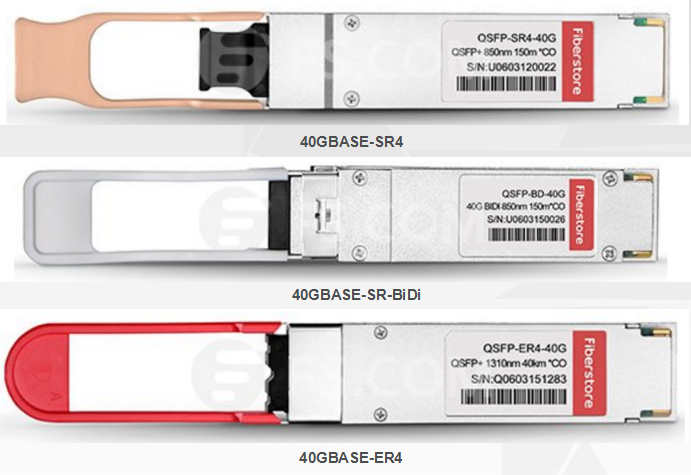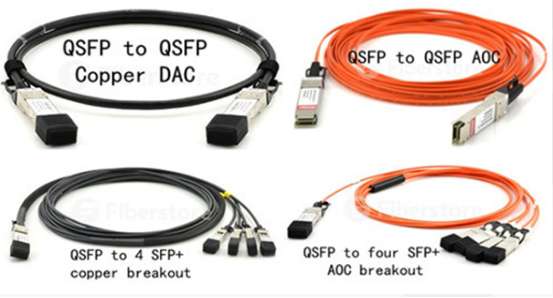It is well known that telecommunication equipment experts have designed and developed a variety of fiber optical products to meet the increasing requirements of our network. As one of the most important components among these fiber optical products, fiber optic transceiver has caused more and more value that has been diversified to achieve higher and higher transmission speed and smaller and smaller size, such as, GBIC, SFP, XFP, SFP+, QSFP+, etc. In this post, it will give a detailed selection guide to QSFP+ transceivers and their cabling options, both of which are very popular and commonly used in building 40G Ethernet network.
QSFP+ transceiver is also known as Quad Small Form-factor Pluggable transceiver, which is designed for 40G Ethernet network. Generally, it has four channels of data in one pluggable interface and each channel has the ability to transmit the data at 10Gb/s rate. Thereby, it can support 40G Ethernet network. The following will introduce three commonly used QSFP+ transceivers, 40GBASE-SR4, 40GBASE-SR-BiDi and 40GBASE-ER4, helping you choose the most suitable one for your network.

40GBASE-SR4 Transceiver
40GBASE-SR4 transceiver can support 40G Ethernet network by transmission through muldi-mode fiber (MMF), which is able to transmit signals at lengths up to 100 meters through laser-optimized OM3 and 150 meters through OM4. The high-bandwidth 40G optical network is set up through 12-fiber parallel fiber that terminated with MPO/MTP multi-fiber female connectors, occupying 4 fibers for sending signals, 4 fibers for receiving signals and 4 fibers wasted. In addition, it can also be applied in a 4x10G mode for interoperability with 10GBASE-SR interfaces, with no change in transmission distance.
40GBASE-SR-BiDi Transceiver
40GBASE-SR-BiDi is a pluggable optical transceiver with a duplex LC connector interface for short distance data communication and interconnect applications, also working with MMF. Each QSFP 40GBASE-SR-BiDi transceiver is composed of two 20G transmitting and receiving channels in the 832-918nm wavelength range, which enables an aggregated 40G link over a two-strand MMF connection. Compared to 40GBASE-SR4 transceiver, this kind of transceivers only requires a duplex LC patch cord to accomplish 40G transmission at lengths up to 100 meters over OM3 and 150 meters over OM4 that works in a much more straightforward transmission mode. In short, 40GBASE-SR-BiDi transceiver gives the users a big convenience to build their 40G Ethernet network.
40GBASE-ER4 Transceiver
Clearly different from the previous transceivers, 40GBASE-ER4 works over single mode fiber (SMF) to finish 40G communication, supporting the link at lengths up to 40km with duplex LC connectors. There are four kinds of wavelengths in the 1310nm range used to transmit signals, which will be multiplexed and demultiplexed in the transmission process. If you want to build your 40 Ethernet network for long distance transmission, this kind of transceivers must be a good choice.
In general, there are three commonly used 40G QSFP+ cabling options, QSFP to QSFP copper direct attach cables (DACs), QSFP to QSFP active optical cables (AOCs), QSFP to four SFP+ breakout cables as shown in the following figure. To better understand the features of these cabling options, you can take the listed information as reference.

As for QSFP to QSFP Copper DACs and QSFP to QSFP AOCs, both of them are developed for short distance transmission by providing a flexible solution for connection within racks and across adjacent racks. In contrast to DACs, AOCs are much thinner and lighter that facilitates the cabling. Since AOCs enable efficient system airflow and have no EMI issues, there is no doubt that AOCs have a higher performance than DACs when designing 40 Ethernet network.
As for QSFP to four SFP+ breakout cables, they are available in two types: QSFP to four SFP+ copper breakout cables and QSFP to four SFP+ active optical breakout cables, which can be in 1m, 2m, 3m, 5m, 7m and 10m. By offering more space for data centers with low cost, this kind of 40G QSFP+ cabling option becomes a highly cost-effective interconnect solution to set up 40 Ethernet network.
From this post, we can conclude that 40GBASE-SR4 and 40GBASE-SR-BiDi transceiver are commonly used in short distance 40G transmission, while 40GBASE-ER4 can support 40G transmission with long distance. As for the 40G QSFP+ cabling options, you can choose the most suitable one to match your network. Hope the information in this post would be helpful for your 40G QSFP+ optics selection.









